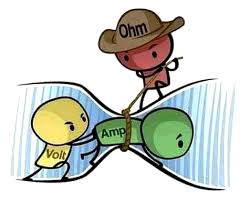[Español]
Los primeros tres conceptos básicos
En esta oportunidad vamos a profundizar en los tres primeros conceptos fundamentales que son esenciales para comenzar a comprender la electrónica, lo cual nos brindará una base sólida para adentrarnos en el fascinante mundo de la electrónica y sus aplicaciones.
- La corriente eléctrica (I) se puede imaginar como el flujo de pequeñas partículas llamadas electrones a través de un conductor, como un camino por el que viajan, y se mide en Amper (A). Esto puede concebirse como el movimiento ordenado de partículas en respuesta a una fuerza que las empuja en un circuito.
- El voltaje (V) es la fuerza impulsora detrás del flujo de electrones en un circuito, representando la diferencia de potencial entre dos puntos y se mide en Volt (V). Una analogía útil sería pensar en esto como la presión que proporciona una bomba de agua en un hogar.
- La resistencia (R) es la propiedad de un material para resistirse al flujo de electrones. Los metales son buenos conductores, mientras que los plásticos son malos conductores, y se mide en Ohm (Ω).
Habiendo conocido estos tres conceptos, podemos empezar a comprender la Ley de Ohm, formulada por el físico alemán Georg Simon Ohm. Esta ley establece la relación matemática entre corriente eléctrica, voltaje y resistencia, expresada mediante la ecuación V = I * R, donde V representa el voltaje en volt, I la corriente eléctrica en amper, y R la resistencia en ohm.
Esta ecuación nos indica que el voltaje en un circuito es igual al producto de la corriente eléctrica y la resistencia, lo que significa que el voltaje es proporcional a la corriente y a la resistencia en el circuito. Por lo tanto, si aumentamos el voltaje o la resistencia en un circuito, la corriente también aumentará, y viceversa.
La Ley de Ohm es esencial en la electrónica, ya que nos permite predecir y controlar el comportamiento de los circuitos eléctricos, lo que nos facilita el diseño de circuitos más eficientes, seguros y funcionales para una amplia gama de aplicaciones, desde dispositivos electrónicos simples hasta sistemas de potencia más complejos.
[English]
The first three basic concepts
On this occasion we are going to delve into the first three fundamental concepts that are essential to begin to understand electronics, which will provide us with a solid foundation to enter the fascinating world of electronics and its applications.
- Electric current (I) can be thought of as the flow of small particles called electrons through a conductor, like a path they travel along, and is measured in Amperes (A). This can be thought of as the ordered movement of particles in response to a force pushing them in a circuit.
- Voltage (V) is the driving force behind the flow of electrons in a circuit, representing the potential difference between two points and is measured in Volt (V). A useful analogy would be to think of this as the pressure provided by a water pump in a home.
- Resistance (R) is the property of a material to resist the flow of electrons. Metals are good conductors, while plastics are poor conductors, and it is measured in Ohm (Ω).
Having known these three concepts, we can begin to understand Ohm's Law, formulated by the German physicist Georg Simon Ohm. This law establishes the mathematical relationship between electric current, voltage and resistance, expressed by the equation V = I * R, where V represents the voltage in volts, I the electric current in amperes, and R the resistance in ohms.
This equation tells us that the voltage in a circuit is equal to the product of the electric current and the resistance, which means that the voltage is proportional to the current and the resistance in the circuit. Therefore, if we increase the voltage or resistance in a circuit, the current will also increase, and vice versa.
Ohm's Law is essential in electronics, as it allows us to predict and control the behavior of electrical circuits, making it easier for us to design more efficient, safe and functional circuits for a wide range of applications, from simple electronic devices to More complex power systems.

Greetings @profwhitetower ,
So appreciate the subject matter...and the detailed organised way you presented it....thank you.
Welcome to Hive!
Kind Regards,
Bleujay
Thank you, Bleujay! I'm very glad you liked it. I'm excited to join Hive and I hope to contribute more interesting ideas. See you soon! And of course, I invite you to stay for the next topics!
A big hug,
Prof.Whitetower
Congratulations @profwhitetower! You have completed the following achievement on the Hive blockchain And have been rewarded with New badge(s)
Your next target is to reach 50 upvotes.
You can view your badges on your board and compare yourself to others in the Ranking
If you no longer want to receive notifications, reply to this comment with the word
STOPCheck out our last posts:
[ESP]
Buenisimo! Yo no habia hecho mis publicaciones de electronica en los dos lenguajes. Ademas nos da otra perspectiva para profundizar mas el tema.
[ENG]
Awesome! I hadn't made my posts with both languages. Plus this gives us a different perspective to deepen our understanding of the subject.